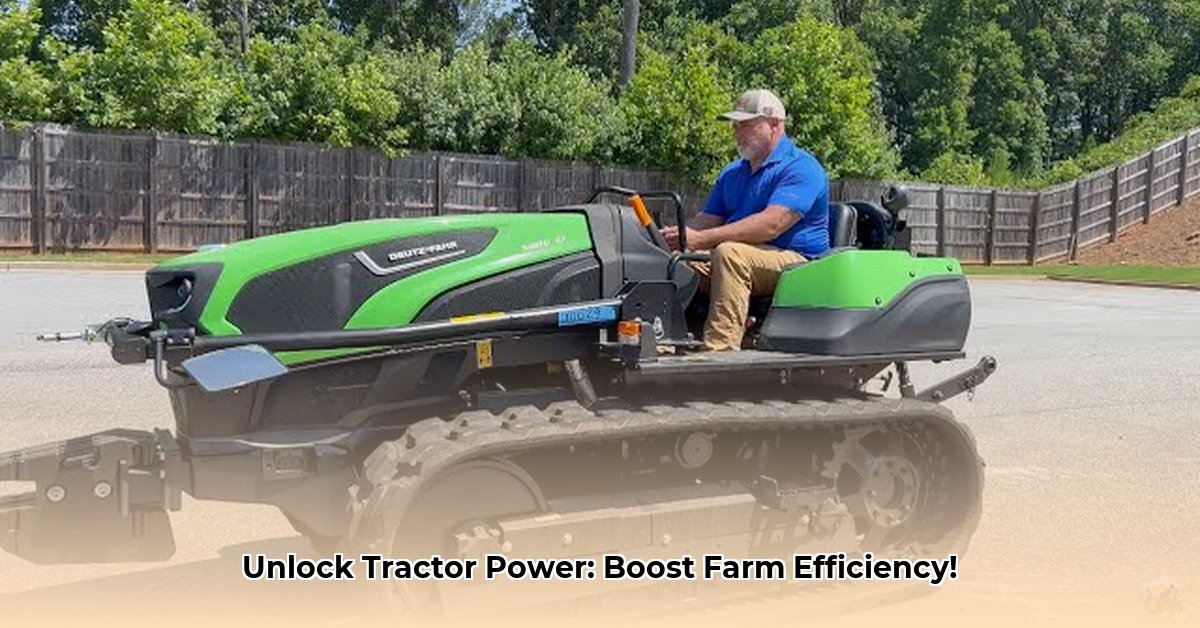
Crawler Tractors: A Deep Dive into Modern Agricultural Powerhouses
Crawler tractors, with their distinctive track system, represent a critical component of modern agriculture. Far from outdated relics, they've undergone significant technological advancements, boasting enhanced efficiency and precision capabilities. This article explores the evolution of crawler tractors, the market landscape, their advantages and disadvantages, and the exciting future innovations on the horizon. For choosing the right implements, consider factors like tractor horsepower; learn more about matching horsepower to implements.
The Evolution of Crawler Tractor Technology
The journey of the crawler tractor is a testament to engineering innovation. Early models, limited by basic engine technology and mechanical transmissions, have been transformed into sophisticated machines. Advancements in diesel engine technology have dramatically increased horsepower and efficiency, reducing fuel consumption. The development of power-shift and hydrostatic transmissions has resulted in smoother, more precise control, allowing for more accurate and efficient operation. The integration of GPS and automated steering systems further enhances precision, transforming crawler tractors into high-precision tools for modern agricultural practices.
Navigating the Crawler Tractor Market
The crawler tractor market is segmented by power, application, and features. Smaller tractors are ideal for smaller fields and delicate tasks, while larger models perform heavier work on extensive acreage. Major manufacturers, including John Deere, Caterpillar, Komatsu, and Case IH, compete in this market, offering diverse models tailored to specific needs. The selection process demands careful consideration of horsepower, features such as enclosed cabs and rollover protection, and the intended applications.
Advantages and Disadvantages of Crawler Tractors
Crawler tractors offer several compelling advantages: superior traction minimizes soil compaction, a critical factor for long-term soil health and productivity. Their versatility makes them suitable for a wide range of tasks, from plowing and tilling to heavy hauling. However, they also present some disadvantages. The initial investment is substantial, and maintenance costs can be significant. Additionally, their operating speed is typically slower than wheeled tractors. Despite these drawbacks, many farmers find the long-term benefits, such as reduced soil damage and improved efficiency, to outweigh the initial cost and slower operating speed.
| Advantage | Disadvantage |
|---|---|
| Exceptional Traction | High Initial Cost |
| Reduced Soil Compaction | Higher Maintenance Expenses |
| Versatility | Slower Operating Speed |
| Superior Stability | Specialized Maintenance Needed |
Precision Agriculture and Crawler Tractors
The integration of GPS, automated steering, and other precision agriculture technologies has revolutionized the use of crawler tractors. These advancements allow for pinpoint accuracy in planting, fertilization, and chemical application, minimizing waste, maximizing yields, and promoting sustainable farming practices.
Future Trends in Crawler Tractor Technology
The future of crawler tractors promises even more innovation. The increasing integration of artificial intelligence (AI) and autonomous operation will lead to tractors that operate independently with minimal human intervention. The shift toward alternative fuel sources, such as biofuels and hydrogen, will reduce reliance on fossil fuels and lessen the environmental impact. Manufacturers are constantly striving for greater efficiency, reduced environmental footprints, and enhanced operator comfort.
Actionable Insights for Farmers and Manufacturers
For Farmers:
- Assess Needs: Carefully evaluate your farm's specific requirements—soil type, field size, and necessary tasks—before purchasing a crawler tractor.
- Explore Financing: Investigate various financing options, including loans and leasing, to find the best fit for your budget.
- Embrace Precision: Utilize GPS guidance and other precision agriculture technologies to optimize resource use and maximize yields.
For Manufacturers:
- Prioritize Safety: Continuously improve operator safety features like ROPS and ergonomic designs for enhanced comfort.
- Develop Data Analytics: Create advanced data analytics systems to enable proactive machine health management.
- Design Eco-Friendly Autonomous Models: Focus on developing fully autonomous crawler tractors powered by sustainable energy sources.
Is there a better way to improve overall farm efficiency? Crawler tractors offer a powerful solution, and their continued evolution promises even greater benefits in the years to come. The combination of increased power, precision, and sustainability makes them an essential tool for modern agriculture. By understanding their capabilities and potential, farmers can significantly enhance their operations and contribute to a more sustainable future.